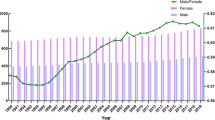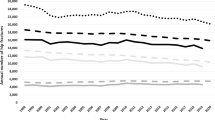Abstract
The aim of this study was to quantify the global burden of osteoporosis as judged by hip fracture and the burden in different socio-economic regions of the world. The population mortality in 1990 and the incidence of hip fracture in different regions were identified, where possible in 1990. Excess mortality from hip fracture used data for Sweden, and disability weights were assigned to survivors from hip fracture. In 1990 there were an estimated 1.31 million new hip fractures, and the prevalence of hip fractures with disability was 4.48 million. There were 740,000 deaths estimated to be associated with hip fracture. There were 1.75 million disability adjusted life-years lost, representing 0.1% of the global burden of disease world-wide and 1.4% of the burden amongst women from the established market economies. We conclude that hip fracture is a significant cause of morbidity and mortality worldwide.
Similar content being viewed by others
References
De Laet CE, van Hout BA, Hofman A, Pols HA (2002) [Costs due to osteoporosis-induced fractures in The Netherlands; possibilities for cost control]. Nederlands Tijdschrift voor Geneeskunde, CBO, Utrecht
Kanis JA, Pitt FA (1992) Epidemiology of osteoporosis. Bone 13:S7–S15
Lau EMC, YH Chan, M Chan, J Woo, J Griffith, HHL Chan, PC Leung (2000) Vertebral deformity in Chinese men: prevalence, risk factors, bone mineral density and body composition measurements. Calcif Tissue Int 66:47–52
Johnell O (1997) The socioeconomic burden of fractures: today and in the 21st century. Am J Med 103:20S–25S; discussion 25S–26S
Randell A, Sambrook PN, Nguyen TV, Lapsley H, Jones G, Kelly PJ, Eisman JA (1995) Direct clinical and welfare costs of osteoporotic fractures in elderly men and women. Osteoporos Int 5:427–432
Ray NF, Chan JK, Thamer M, Melton LJ III (1997) Medical expenditures for the treatment of osteoporotic fractures in the United States in 1995: report from the National Osteoporosis Foundation. J Bone Miner Res 12:24–35
Fox Ray N, Chan JK, Thamer M, Melton III LJ (1997) Medical expenditures for the treatment of osteoporotic fractures in the United States in 1995: report from the National Osteoporosis Foundation. J Bone Miner Res 12:24–35
Cooper C, Campion G, Melton LJ III (1992) Hip fractures in the elderly: a world-wide projection. Osteoporos Int 2:285–289
Gullberg B, Johnell O, Kanis JA (1997) World-wide projections for hip fracture. Osteoporos Int 7:407–413
Murray CJL, Lopez AD (1996) Global health statistics: a compendium of incidence, prevalence and mortality estimates for over 200 countries. Harvard School of Public Health, USA
Murray CJL (1996) Rethinking DALYs. In: Murray CJL, Lopez AD (eds) The global burden of disease. WHO, Geneva, pp 1–89
World Bank (1993) World development report 1993. Investing in health. Oxford University Press, New York
Murray CJL, Lopez AD (1996) The global burden of disease: a comprehensive assessment of mortality and disability from diseases, injuries and risk factors in 1990 and projected to 2020. Harvard University Press, Cambridge, Mass.
Schwartz AV, Kelsey JL, Maggi S, Tuttleman M, Ho SC, Jonsson PV, Poor G, Sisson de Castro JA, Xu L, Matkin CC, Nelson LM, Heyse SP (1999) International variation in the incidence of hip fractures: cross-national project on osteoporosis for the World Health Organization programme for research on ageing. Osteoporos Int 9:242–253
Ling X, Aimin L, Xihe Z, Xiaoshu C, Cummings SR (1996) Very low rates of hip fracture in Beijing, People’s Republic of China. The Beijing Osteoporosis Project. Am J Epidemiol 144:901–907
Yan L, Zhon B, Prentice A, Wang X, Golden MHN (1999) Epidemiological study of hip fracture in Shenyang, People’s Republic of China. Bone 24:151–155
Memon A, Pospula WM, Tantawy AY, Abdul-Ghafar S, Suresh A (1998) Incidence of hip fracture in Kuwait. Int J Epidemiol 27:860–865
Oden A, Dawson A, Dere W, Johnell O, Jonsson B, Kanis JA (1998) Lifetime risk of hip fractures is underestimated. Osteoporos Int 8:599–603
Kanis JA, Oden A, Johnell O, De Laet C, Jonsson B, Oglesby AK (2003) The components of excess mortality after hip fracture. Bone 32:468–473
Parker MJ, Anand JK (1991) What is the time mortality of hip fractures. Public Health 105:443–446
Murray CJL, Lopez AP (1996) Global and regional descriptive epidemiology of disability: Incidence, prevalence, health expectancies and years lived with disability. In: Murray CJL, Lopez AD (eds) The global burden of disease: a comprehensive assessment of mortality and disability from diseases, injuries and risk factors in 1990 and projected to 2020. Cambridge University Press, Cambridge, pp 201–246
National Osteoporosis Foundation (1998) Osteoporosis: cost effectiveness analysis and review of the evidence for prevention, diagnosis and treatment. Osteoporos Int 8: S1–S88
Kanis JA, Oden A, Johnell O, Jonsson B, De Laet C, Dawson A (2000) The burden of osteoporotic fractures: a method for setting intervention thresholds. Osteoporos Int 12:417–427
Kanis JA, Johnell O, Oden A, Borgstrom F, Zethraeus N, De Laet C, Jonsson B (2003) Risk and burden of vertebral fractures in Sweden. Osteoporos Int 15:20–26
Williams A (1999) Calculating the global burden of disease. Time for a strategic reappraisal. Health Econ 8:1–8
Cooper C, Atkinson EJ, Jacobson SJ, O’Fallon WM et al. (1993) Population-based study of survival after osteoporotic fractures. Am J Epidemiol 137:1001–1005
Magaziner J, Simonsick EM, Kasher TM, Hebel JR et al. (1989) Survival experience of aged hip fracture patients. Am J Public Health 79:274–278
Poor G, Atkinson EJ, O’Fallon WM, Melton LJ (1995) Determinants of reduced survival following hip fractures in men. Clin Orthop Rel Res 319:260–265
Lopez Vaz A (1993) Epidemiology and costs of osteoporotic hip fractures in Portugal. Bone 14:S9
Brazier J, Green C, Kanis JA on behalf of the Committee of Scientific Advisors, International Osteoporosis Foundation 2002 (2002) A systematic review of health state utility values for osteoporosis. Osteoporos Int 13:768–776
Acknowledgement
We are grateful to Drs. Rafael Lozano and Colin Mathers, WHO, Geneva, for their help in reviewing the manuscript. The work was undertaken within the terms of reference of NEMO, funded by the EC.
Author information
Authors and Affiliations
Corresponding author
Rights and permissions
About this article
Cite this article
Johnell, O., Kanis, J.A. An estimate of the worldwide prevalence, mortality and disability associated with hip fracture. Osteoporos Int 15, 897–902 (2004). https://doi.org/10.1007/s00198-004-1627-0
Received:
Accepted:
Published:
Issue Date:
DOI: https://doi.org/10.1007/s00198-004-1627-0




